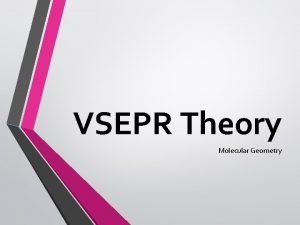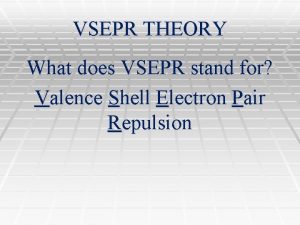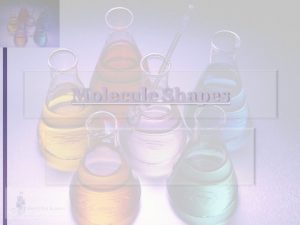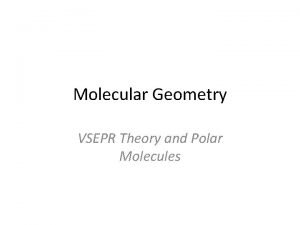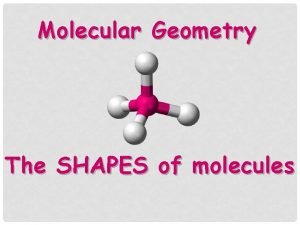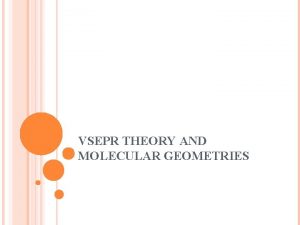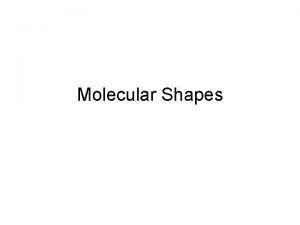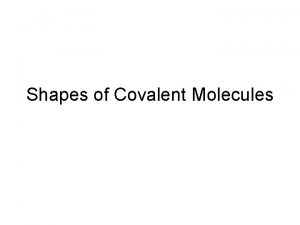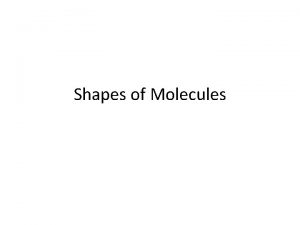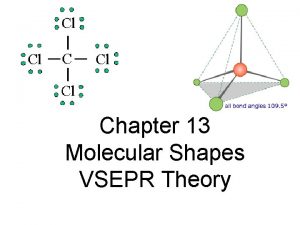Section 4 Molecular Shapes The VSEPR model is









- Slides: 9

Section 4: Molecular Shapes The VSEPR model is used to determine molecular shape. K What I Know W What I Want to Find Out L What I Learned

• 7(E) Predict molecular structure for molecules with linear, trigonal planar, or tetrahedral electron pair geometries using Valence Shell Electron Pair Repulsion (VSEPR) theory. • 7(B) Write the chemical formulas of common polyatomic ions, ionic compounds containing main group or transition metals, covalent compounds, acids, and bases. • 7(C) Construct electron dot formulas to illustrate ionic and covalent bonds. Copyright © Mc. Graw-Hill Education Molecular Shapes

Essential Questions • What is the VSEPR bonding theory? • How can you use the VSEPR model to predict the shape of, and the bond angles in, a molecule? • What is hybridization? Copyright © Mc. Graw-Hill Education Molecular Shapes

Vocabulary Review New • atomic orbital • VSEPR model • hybridization Copyright © Mc. Graw-Hill Education Molecular Shapes

VSEPR Model The shape of a molecule determines many of its physical and chemical properties. Molecular geometry (shape) can be determined with the Valence Shell Electron Pair Repulsion model, or VSEPR model which minimizes the repulsion of shared and unshared atoms around the central atom. • Electron pairs repel each other and cause molecules to be in fixed positions relative to each other. • Unshared electron pairs also determine the shape of a molecule. • Electron pairs are located in a molecule as far apart as they can be. Copyright © Mc. Graw-Hill Education Molecular Shapes

Hybridization is a process in which atomic orbitals mix and form new, identical hybrid orbitals. Carbon often undergoes hybridization, which forms an sp 3 orbital formed from one s orbital and three p orbitals. Lone pairs also occupy hybrid orbitals. Single, double, and triple bonds occupy only one hybrid orbital (CO 2 with two double bonds forms an sp hybrid orbital). Copyright © Mc. Graw-Hill Education Molecular Shapes

FIND THE SHAPE OF A MOLECULE Use with Example Problem 7. Problem Phosphorus trihydride, a colorless gas, is produced when organic materials, such as fish flesh, rot. What is the shape of a phosphorus trihydride molecule? Predict the bond angle and identify hybrid orbitals. Response ANALYZE THE PROBLEM A phosphorus trihydride molecule has three hydrogen atoms bonded to a central phosphorus atom. Copyright © Mc. Graw-Hill Education Molecular Shapes

Find the Shape of a Molecule SOLVE FOR THE UNKNOWN EVALUATE THE ANSWER • All electron pairs are used and each atom has a stable electron configuration. Draw the Lewis structure, using one pair of electrons to bond each H atom to the central P atom and assigning the lone pair to the P atom. The molecular shape is trigonal pyramidal with a predicted 107° bond angle and sp 3 hybrid orbitals. Copyright © Mc. Graw-Hill Education Molecular Shapes

Review Essential Questions • What is the VSEPR bonding theory? • How can you use the VSEPR model to predict the shape of, and the bond angles in, a molecule? • What is hybridization? Vocabulary • VSEPR model Copyright © Mc. Graw-Hill Education • hybridization Molecular Shapes
 How to memorize molecular geometry
How to memorize molecular geometry The basis of the vsepr model of molecular bonding is _____.
The basis of the vsepr model of molecular bonding is _____. Molecular structure
Molecular structure What does vsepr stand for
What does vsepr stand for Lewis structure shape chart
Lewis structure shape chart Vsepr theory angles
Vsepr theory angles Vespr chart
Vespr chart Covalent bond melting point
Covalent bond melting point Giant molecular structure vs simple molecular structure
Giant molecular structure vs simple molecular structure Giant molecular structure vs simple molecular structure
Giant molecular structure vs simple molecular structure
